#copper washers
Photo



A copper-red-glazed washer
Qing dynasty, 19th century
Diameter 9 in., 23 cm.
#A copper-red-glazed washer#Qing dynasty 19th century#pottery#ancient pottery#ancient artifacts#history#history news#ancient history#ancient civilizations#ancient china#chinese history#chinese art#china
20 notes
·
View notes
Text
#EMI shielding honeycomb vent panel china#fabric over foam gasket china#Berrylium copper Finger stock gasket china#EMI washer china
0 notes
Text

Copper Washer
#Copper Washer#Copper Washer Manufacturers#Copper Washer Suppliers#Copper Washer Exporters#Copper Washer Importers.
0 notes
Text
Copper Washer Manufacturer in Delhi - SBP Auto
SBP Auto is a leading copper washer manufacturer in Delhi. With over 44 years of experience, we have provided quality copper washers to our customers worldwide. Our products are made from the finest quality raw materials and are designed to meet the highest quality and safety standards. We have a team of highly skilled professionals who work hard to ensure that all our products meet the required standards. With our commitment to providing excellent customer service, we strive to provide our customers with the best possible solutions for their needs. SBP Auto is committed to providing superior quality products that meet the highest safety and performance standards. The company utilizes state-of-the-art technology to ensure that all its products are of the highest quality and meet customer requirements. With its extensive experience in manufacturing copper washers, SBP Auto is well-positioned to provide customers with reliable and cost-effective solutions for their needs. SBP Auto is a leading copper washer manufacturer in Delhi, India. With over 44 years of experience in the industry, we have been providing quality copper washers to a wide range of customers across India. We are known for our superior quality products, competitive prices, and timely delivery. Our experienced professionals are committed to providing our clients with the best possible service. We use only the highest-grade materials for manufacturing copper washers, and our products are designed to deliver superior performance and durability. So if you need reliable copper washers in Delhi, look no further than SBP Auto! Copper Crush Sealing Washers Uses Some of the uses of Copper Crush Sealing Washers are: In various industrial machines, automobile engines, and many more. They were used on construction sites for plumbing and electrical components that require excellent heat and electrical conductivity. To seal unions with fluids/liquids in electric motors. They are used in many electronic devices and gadgets.


0 notes
Text
Guide to Copper Washers
What are Copper Washers?
Copper washers are flat rings made from pure copper. They have a small thickness and are used to distribute pressure and reduce friction between two surfaces. Copper Washers are available in different sizes, shapes, and thicknesses to meet the specific needs of different applications.
They are used in various industries, such as plumbing, construction, automotive, aerospace, and electrical.
Applications of Copper Washers
Copper washers have a wide range of applications due to their excellent properties. One of the most common applications of copper washers is in plumbing. Copper washers are commonly used in plumbing applications such as water heaters, faucets, and pipes.
They are also used in construction applications such as roofing, gutters, and flashings. Copper washers are also widely used in the automotive industry to provide electrical conductivity, sealing, and heat dissipation. At Asiad Steel, you can find a Copper Washers Weight Chart that is available for your reference.

Advantages of Copper Washers
Copper washers have many advantages over other types of washers. Firstly, copper washers are highly corrosion-resistant, making them ideal for outdoor applications.
Secondly, they have excellent thermal and electrical conductivity, which makes them ideal for electrical applications. Furthermore, copper washers are highly durable, which ensures long-term performance and reduces replacement costs. Additionally, copper washers are easy to install and maintain, which saves time and money.
Types of Copper Washers
There are various types of copper washers, each designed for different applications. The most common copper washers include plain copper washers, serrated copper washers, and groove copper washers. Plain copper washers are the most basic design for general-purpose applications.
Serrated copper washers have small teeth on the surface, which helps them grip the surface and prevent loosening. Groove copper washers are designed to fit into grooves and provide a secure fit.
#Types of Copper Washers#Advantages of Copper Washers#Guide to Copper Washers#What are Copper Washers#Applications of Copper Washers
0 notes
Photo

Calgary Laundry Laundry Room
#Large mountain style single-wall dedicated laundry room photo with a farmhouse sink#shaker cabinets#distressed cabinets#granite countertops#multicolored walls and a side-by-side washer/dryer hand hammered copper#stone#private residence#family gathering place#native trails#rustic yet elegant#log home
0 notes
Photo
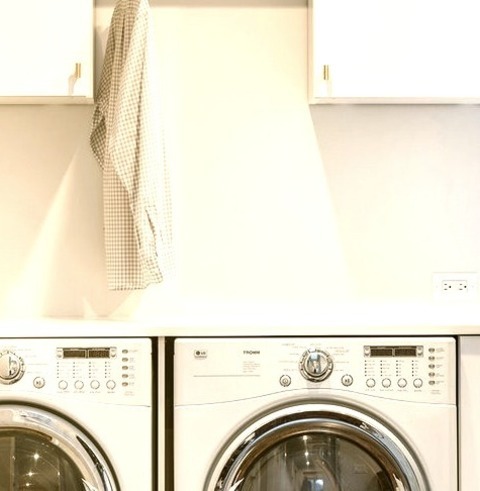
Laundry Multiuse (Kansas City)
#Idea for a small#modern#single-wall utility room with a dark wood floor#white walls#and side-by-side washer and dryers in the cabinets with flat panels. modern#lg washer#pietra gray marble#skylights#copper hardware
0 notes
Text
#Copper Washer Manufacturers#Copper Washer Suppliers#Copper Washer Exporters#Copper Washer Traders#Copper Washer Manufacturers In India#Copper Washer Suppliers In India#Copper Washer Exporters In India#Copper Washer Traders In India#Copper Washer In India#Copper Washer#India
0 notes
Note
can we have more disowned!Jason pls??
Bruce was thankful for the drive. It gave him time to think. Mostly of things to say.
He'd sent a new washer and dryer, only to have them politely but firmly refused. Not by Jason, which he expected, but by you. You explained that it was appreciated but not necessary. And then before hanging up the phone, suggested that he donate the money to a support group for estranged parents. Electronics for the kids were similarly received- albeit less politely by Jason. Jason outright sent them back in pieces.
It was a risk, and he knew that. But by the time he pulled into town and was driving down tree-lined streets he was resolved. He had grandchildren now. He had a son who was happy. A Daughter in law... It was- well. Not a 'normal' family but, why did that matter?
There was a new baby on the way. Surely you had to need something to make it easier? College funds? Was the house paid for? He went through the options over and over. Considering the things he knew from the court documents. How you'd come to have your niece and nephew in your custody. The long sad story that got there.
You were steadfast and compassionate- that he knew. And proud. An offer that felt like charity would be rejected. Because you were doing it- or had been doing it on your own. Caring for your grandmother and then your mother. Fighting with the courts. Running a business. And raising two kids. You didn't want charity.
He pulled up on the curb and checked his watch, frowning. Both cars were still in the drive. Which was odd. Dick had told him you usually took the kids to school and opened the store.
He walked up the front steps and rang the bell. Greeted by the cacophony of dogs barking and Jason grumbling as he lumbered to the door.
Jason rolled his eyes when he saw Bruce at the door. "Not now-"
"I come in peace," Bruce said holding up his hands.
"Now's not a good time," Jason said, picking up the Yorkie before she could bolt out the door.
"What happened?" Bruce asked, heart dropping. Jason looked tense. Stressed. Upset. "Are the kids-"
"There was a break in at the hardware. Y/N was working late doing the books. Local scumbags busted in looking for tools they could sell. And copper. They didn't know she was there, so when she walked out to see what was happening, they panicked. Busted her in the face a couple times and someone kicked her stomach." Jason exhaled slowly. "Boris got to them and scared them off when he heard her struggling. And then. Fuck. As if it wasn't bad enough, his fucking heart just gave out and her dog died."
"Jason-"
"Now is really not a good time," Jason repeated, swallowing hard.
And all Bruce can do is hug him. Hard. Jason never did do well when women were in danger. When they were attacked like that. And now it was one of HIS women. His wife. The mother of his children. And she hadn't been able to call him for help. "Is... everything okay?" he asked, releasing him when Jason started to pull away.
"They kept her in the hospital for a couple days and they want to keep her on bed rest for a while. They were worried about her back and her ribs. And the stress of it all. But- mostly she just... she's worried about the baby. She's worried about the kids. And she misses Borris."
"A good boy-"
"Her best friend," Jason said, smiling a little. "And then he had to go and prove he really did love her more than me... grumpy old fucker."
"I know it's not a good time," Bruce said, not wanting to add more stress to his son. Or risk upsetting you and making it worse for you. "But if you need anything-"
"Just make sure those scumbags stay in jail," Jason said. "Because if I get my hands on them, I'll break their fucking necks."
"At least you aren't going to shoot-"
"Y/N makes me store my guns and my ammo in two separate places," he sighed. "And she moved it after Ty found it- now I don't know where it is."
208 notes
·
View notes
Text
The supply list Rex keeps in the barracks for anyone to write on:
Ration bar type #A8
Cheez-it’s
Coffee grounds
Black pepper
12 Kilos of bananas
Whipped burrata cheese (please Rex we’re tired of granola bars it’s been months, pretty please! :( ~Fives)
Respirator masks
All bug away bug spray
Antiseptic cream
Bunion cream (there’s been an outbreak of athletes foot again thanks to Hardcase showering without flip flops)
Soap
Socks
Ratchet straps (you know who These are for you son of a bitch you’ve been dodging your physical for a month now)
Bacta spray
Toilet paper
Forceps (Hardcase keeps getting foreign objects lodged in him)
An ass load of anesthesia (Hardcase doesn’t stay asleep or keep still during surgery)
50lbs of C4
Styrofoam
Gasoline
Spark plugs
Bath bombs
Turbine fan (I swear this is all for explosive technicians I’m not doing anything suspicious this time)
Drain fluid
Gender fluid
Wiper fluid
Spinal fluid
Detergent
Chains
Whips
Excitement
Denal was here
Little water fountain that plays soothing music and glows (for Dogmas anxiety ;) )
Hair ties
Shaving cream
Razors
Monistat 7
Condoms
Stickey notes
Crystal meth
Peach tea mix
Strawberry jam
Rights
1,000,000 dollars
Canned baked beans
Giant orbeez
Hair gel
Shampoo/conditioner
Gas-x
Shoe inserts
Tomato plants
Feather duster
100 50,000 thread count satin blankets
Shoe oder powder
Parents
Shrimp
Pink dye
Moisturizer
Space Rachel Ray’s cook book
Potato chips
Metamorphic rocks
A big ass junk yard magnet
Carbon fiber weave cables
Heat treatable silver clay
Grade C gas cartridges
.16 mil washers
Blaster cleaner spray
Whiskey
Vodka
Bourbon
Wine coolers
Margarita mix
Neon fluorescent 18’ light bulbs
Copper wire
Type #2125 breaker board
R2 circuit boards
Deep freeze refrigerator
Fire extinguisher foam refills
Shower caps
Back scratchers
Mouth guards
Toothpaste
Floss
#captain rex#fives#hardcase#kix#tup#dogma#Denal#echo#jesse#the 501st#arc trooper#clone trooper#the clones#tcw#the clone wars#Star Wars#my post#the prequels#shenanigans
230 notes
·
View notes
Text
Some photos of the house under the cut
So it's been sitting empty for 2 years. It has been broken into. They stole some of the copper plumbing, so that will need to be replaced. The exterior doors will need to be replaced because they're smashed up a bit. There is an alarm system installed. High ceilings. It's a weird setup, but doesn't bother me. The fenced yard is nice. Garage is okay. Some of the windows, the seals have gone, so the panes will need to be replaced, but it shouldn't cost TOO much to have everything fixed and good. I'll need a new fridge and maybe washer and dryer. There is some garbage that'll need to be cleaned up, but 🤷♀️








The property taxes aren't cheap, but this might be my only shot and this house is big enough and decent enough that I don't think I'll ever need to move unless I can get my hands on an acreage I like.
The asking price is incredibly low compared to what the house could actually be worth because it's in a sketchy part of town, except there is no sketchy part of town anymore. The whole town is sketchy these days. So whatever. And I've got dogs. I'll be fine.
26 notes
·
View notes
Text
Sunday Steve - Day Ten
Things that would be new or unfamiliar to Steve in the 21st century, either due to the time period he grew up in, or his social-economic status and other such factors.
Day Ten: Laundry — Washer and Dryers
Washing Machine
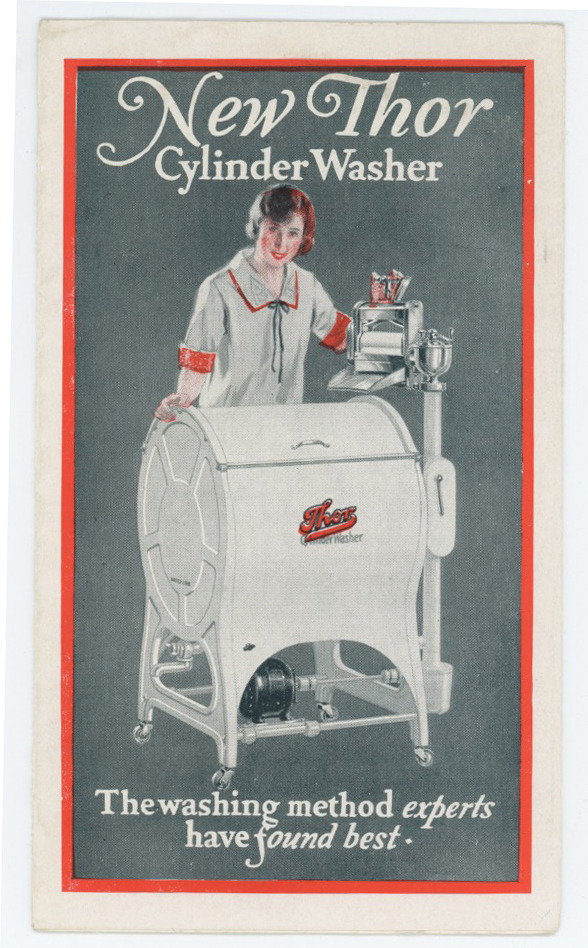
1920s ad for a Thor brand washing machine. One of the first electric washing machines. Note the exposed motor underneath that could shock users when wet. (Imagine Steve associating Thor with washing machines 😆).
Laundry machines have a long history. The first washing machines were invented in the late 1800s. There were mechanical, hand powered machines, consisting of drums full of water and handles to agitate the laundry and turn the rollers to squeeze water from washed clothes.
However, these devices were most common in middle class families. Poor families who could not afford the machines and rich families who did not have to worry about the labour of laundry likely did not have these machines.
Laundry was a laborious task and families who could afford it had hired help to do their laundry or they sent out their laundry to be cleaned and returned.
Here is an account of laundry days in the 1920s for a family who had a scullery. They used a 'washing copper' tub that was built into the floor and had a space for a fire underneath. It is interesting how it describes typical washing without a washing machine, but Steve and Sarah likely lived in a tenement apartment building and did not have these facilities available to them.
We will get into what Sarah probably did when Steve was growing up. But one last laundry innovation to talk about in the 20s was the electric washer. The first electrical washer appeared in the US before the first World War thanks to the invention of the small electric motor (Link).
This blog page gives a good overview of how a domestic electric washing machine worked in 1927. The metal drum was manually filled with water (if you didn't have a hose, lifting and pouring water into the drum was your fate). Pre-prepared soap was added then pre-soaked clothes could be washed. The machines could handle about ten pounds, so clothes had to be regularly transferred in and out. After the wash, clothes were wrung out and put in scalding rinse water to remove soap. Clothes were then wrung out again (maybe rinsed a few more times), starched, and hung to dry. Some families had heated dryer cupboards to hang their clothes.
Domestic washing machines inside the home were not common before the 50s. They were growing in popularity in the 30s, but I doubt Steve every used any type of washing machine in his own home. Depending on how well off you feel the Barneses were they may have had one, but I still feel this wasn't very likely.
In 1920 only 8% of US families owned a washing machine. And by 1941 "only 52% of U.S. families owned or had interior access to an electric washing machine—almost half of families were still hand rubbing or hand cranking laundry or using commercial services" (Link).
Tenement Laundry Days
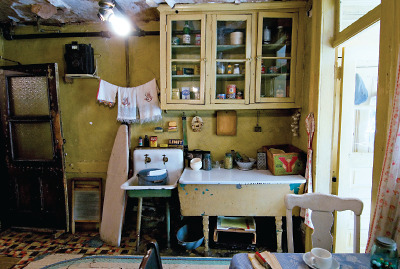
Reproduction of 1928-1935 tenement house.
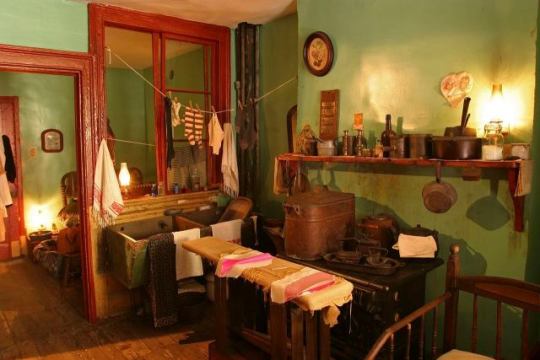
Reproduction of 1890s era tenement apartment.
Wash days were usually on Monday. Sarah probably did these steps: Soaking the laundry, scrubbing, boiling, wringing, rinsing, wringing agin, and finally, hanging to dry. (Link)
In the second picture above a scrub board can be seen in the deep sink. The sink was likely used for soaking, scrubbing and rinsing. Scrub boards were used well into the 20th century.
While indoor plumping for tenements was becoming common in the 20s (especially for toilets), if they didn't have running water Sarah would have to trek up and down flights of stairs to fill her tub from the tap in the yard. (Link) This would most likely only be the case if Steve and Sarah lived in a pre-1905 tenement building as laws about tenements changed around that time. However, many tenements were cold water flats, so water would be boiled on the stove.
In the picture above you can see a large oblong metal tub on the stove. This is likely what was used for boiling.
After soaking (usually started Sunday night) clothes that were still soiled would be scrubbed, then the laundry was boiled. Clothes were boiled in water for an hour and stirred with a rod or wooden stick. They would then be removed with a fork or a rod, wrung out, rinsed (to remove soap) and wrung out again.
If Sarah (or Winifred) was able to afford it she may have a mangle to squeeze the water from washed clothes ($5.95-8.00 for a basic one in 1920). These two wooden rollers were dangerous because women could get their fingers or hair caught in them. They also sometimes damaged or broke off buttons. If she didn't have one, she'd wring them out by hand.
The spin cycle was developed to wring out clothes, and some electric washers had this feature going into the 30s. (Link)
Once wrung out, the clothes were hung to dry. In the winter clothes could be hung in front of the fireplace or stove (on a clothes horse for those who had one) if there was space, but they could also be hung outside to freeze and brought in before nightfall.
Tenement buildings commonly had clotheslines strung between buildings. "The advantage of living on a low floor (with fewer flights of stairs to climb) became a disadvantage on wash day, because when hanging your laundry out to dry, ‘someone else might put out a red wash or a blue wash over it, and it drips down and makes you do your wash all over again." (Link)

Berenice Abbott (1898-1991). Court of the First Model Tenements in New York City. March 16, 1936. Museum of the City of New York. (Link, many other examples of tenement clotheslines here. I think this is multiple days of laundry lines in one picture).
Abbott documented this space as a communal laundry line: ropes with pulleys led from apartments to five-story poles imbedded in concrete. Abbott made two exposures, with the laundry and poles forming different abstract configurations. She later recalled that winter day the laundry frozen stiff and the children huddled together, too cold to move.
If you didn't have a clothesline near your window you could dry your clothes on the roof. This required climbing more stairs and keeping an eye out for thieves. (Link)
Tuesdays were ironing days. There were electric irons in the 20s but people also still used multiple irons that had to be heated on the stove. Clothes needed to be damp and sprinkled with water while ironing. That is until steam irons were introduced in the 30s. (Link)
However:
What did Steve do after Sarah died? The same thing the Rogers would have done if Sarah had no time to do laundry, which is likely because she worked full time and laundry was an long chore. If Sarah did do her own laundry as well as worked, she would have worked very long hours trying to stay on top of everything.
For those who couldn't do laundry they would send out their laundry. The peak of the commercial laundry industry was in the 1920s. Many laundries were owned by Chinese immigrants and these laundries catered to single men. (Link) These laundries were cheaper than white-owned steam laundries, which generally catered to large institutions like hotels and hospitals, although they advertised to women as well. Here is a picture of a large commercial laundry.
Sending out laundry may have been a necessary expense on Sarah and Steve's part that they had to budget for. This recounting of a Chinese laundry has the clothes dried and ironed by the workers.
Women, especially black women, took laundry into their home. It is possible Sarah and Steve sent out their laundry to washerwomen, perhaps even one who lived in their own tenement. (Link)
If Sarah did not have the time, nor could afford to send out laundry (especially in the 30s), Steve may have had to deal with the shame of going to school in dirty clothes. Cleanliness was a point of pride and I'm certain Sarah would have made every effort to keep him clean but it may not have always been possible.
Laundry soap
Here is what was most typically used as laundry soap. It was also common, especially for rural families, to make their own soap out of lye and grate or cut up that as laundry soap. (Link)
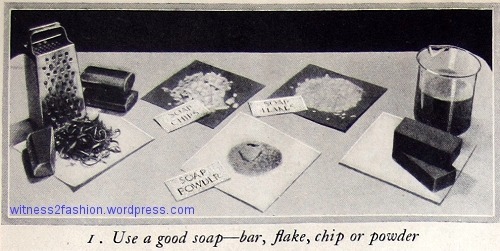
(Link) Laundry soap options in 1927. They included purchasing flakes, chips, or powder; liquifying your soap ahead of time (right); and (left) grating your own laundry soap from a bar. Fels Naptha soap, which came in a big bar, was rubbed on difficult stains and rings around the collar.
Laundromats
The first laundromat or 'washateria' was opened in Texas in 1934. (Link) Laundromats grew in popularity and spread across the country. These early laundromats had rentable electric washing machines like the ones already mentioned in this post. Clothes were taken home damp to be ironed.
In the 40s the name laundromat became common to describe self-serve laundry. This name actually comes from a brand of automatic washing machine. (Link) Laundromats helps familiarize consumers with washing machines and grow their trust in them, thus ushering in the domestic washing machine age in the 50s and 60s and the decline of commercial laundry services.
Steve may have used a washateria or laundromat in the late 30s or early 40s but the machines would be different. They may have looked something like this:

Toploading washing machine bought in 1939 (Link) It has a motorized mangle.
This blog also has many 1940s ads to show other styles of washing machines. I think our modern washings machines would be somewhat recognizable if Steve saw these ads, but in general washing machines now look very different from the ones he probably saw.
Dryers
If one didn't hang their clothes to dry they were probably wealthy enough to have air dryers which became available in the early 1920s. These were rooms or cupboards. "These dryers could be powered by electricity, gas, or kerosene. In a good dryer, heated air circulated around the clothing so that the clothes did not bake and yellow. The hot air was pulled out of the cabinet and up a chimney" (Link).
Richer folks could also have their clothes dry in sunlit or steam-heated rooms at the top of their mansion or townhouse. (Link).

A sailor getting a uniform out of a clothes dryer in 1943 (link)
The first electric dryer was manufactured in 1938. (Link) Here's a picture of a 1940s dryer, it looks a bit like an oven.
Automatic dryers were slower to arrive. Launderettes had dryers after the war and this helped facilitate the arrival of dryers in the home.
Before dryers became common in laundromats clothes were taken back damp and ironed. This was more or less ideal anyways since clothes needed to be damp to be ironed if you didn't have a steam iron (which was still a luxury).
Dryers would be very new or completely foreign for Steve. I doubt he used one.
Army Laundry Days
This post is already long (I know), so quick coverage of what I found here.
Army training camps had laundries. The army developed laundry trucks (Quarter Master Laundry Units) to service medical units and troops in the field.
When the trucks couldn't keep up with the front (although they did their best) soldiers made arrangements with local laundries or cleaned their clothes themselves.
Clothing exchange was sometime done instead of cleaning and returning the same clothes to speed up the process. This was done most often with front line troops, often in conjunction with showers.
Steve specialised uniform (really, all of the commandos' uniforms) would probably complicate this process which is really interesting to think about. This wash trucks wouldn't be able to just bring standard uniforms to switch out since they were all wearing different uniforms from different armies. If it could be arranged beforehand they might be able to bring a new uniform for Steve, but I wonder if he wore regular fatigues most of the time and only switched into his Captain America suit during active missions to make things easier.
The mobile laundries also organized clothing repair.
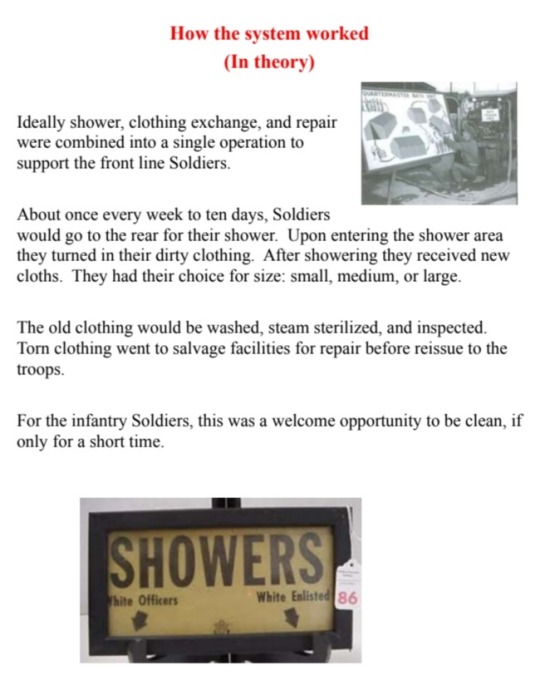
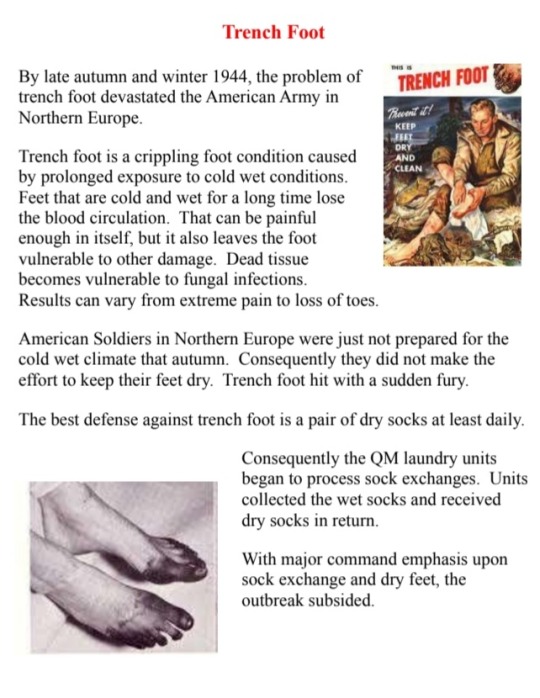
This post got really long! I didn't get into the detailed steps of laundry before modern technologies really took off. But needless to say there's still a lot that could be said.
I have a housekeeping book from 1952 that goes into detail how to wash clothes. If anyone is interested in a post about that, you can let me know. I also have a catalogue reproduction showing laundry machines and prices from the early 20th century if anyone is interested,
Sunday Steve Masterpost
#sunday steve#steve rogers#laundry#washing machines#dryers#early 20th century#american history#history#Sarah rogers#washing clothes#laundromat#steve rogers meta#meta
33 notes
·
View notes
Text
GallaCatch Up
This @galladrabbles is for the prompt "zipper" from @iansfreckles
“You do laundry?” Ian asked Mickey as he rifled through drawers.
“Yeah, it’s in the washer.”
“I’ll have to go commando today.” Ian groaned.
Mickey raised his eyebrows smirking, “Don’t hear me complainin.”
“No but you will hear me if my pubes get caught in the zipper again. Last time I nearly did a landscaping overhaul.”
Mickey laughed coming up next to Ian and watched his pants rise over the thatch of copper curls.
“So long as you don’t pull a “There’s Something About Mary” I think you’ll be okay cupcake.” He teased.
“Besides, nothing I can’t kiss better after.”
#Ian whines when this happens#but Mickey is right#he can kiss anything better after#especially anything of ian's#well except his ass apparently#galladrabbles#ian gallagher#mickey milkovich#gallavich#shameless
21 notes
·
View notes
Text
A brief tale of adventures in repair and stupid coincidences
So last weekend our dishwasher stopped cleaning stuff well, especially stuff on the top rack. It was also making a really obnoxious groaning/buzzing noise when run. We were contemplating the miserable cost of having to replace the whole thing, but we've also taken it apart and put it back together before, so why not at least give it a try.
And I won't deny that there's a deep satisfaction to feeling handy.
So we dismantle it. As I said, done before, but this time I'm really pulling the thing's guts out, the full sump motor assembly. Side note: the bits of stuff stuck in the drain pipe were beyond nasty. There was a lot of other gross stuff crammed into various recesses and encrusting screens, but that was the stuff that really smelled, I assume it was bits of rancid fat.
Well, the housings are fine, the impeller's fine, the motor shaft spins freely, without noise, and there's no play in it. I'd read once that buzzing from a motor could be a capacitor problem, so we take the fat 23.5μF thing off, and take it to an appliance repair shop, they obviously have a tester and tell us it's just fine. (Note to self, get a multi-meter that isn't from the bargain bin.)
Side note 2, small vicissitudes of life: taking the washing machine out meant disconnecting the hot water supply and the drain hose, which go to the hot water line and drain for the sink. A: turns out, if we take out the T-junction for the hot water line, the line to the faucet is no longer long enough. B: we happened to have a cap for the T-junction to the drain. But putting the mess back together we broke one of the nuts, and it leaked copiously. Cue a day of not being able to use the kitchen sink before we could make it to the hardware store for a replacement drain nut and a cap for the hot water t-junction. (We also got a flexible supply line for the dishwasher, because getting around the rigid copper line was the most frustrating part of working on the thing.)
So we're left with the decision making math. A new sump motor assembly is, shockingly, "only" 160$. (Also incredible is that they still make and sell this same assembly from our 20 year old dishwasher. I guess in some industries if it ain't broke they don't fix it.) A new dishwasher of comparable performance is around 600$. Obviously if the new assembly works, that's a huge savings. If it doesn't though, it's a fair amount of money almost literally down the drain.
We decide to reassemble the dishwasher and see if we've cleaned something or jogged something back into place and it will work better now. I'm halfway done and notice an extra part, a flat washer. In a device that mixes water and electricity, washers are exactly the sort of thing I wanna make sure are right. Nothing else jumped out at me so I hit up the web to figure out where it goes (shout out to Parts Select for hosting diagrams and copious pictures!). As I do so, something catches my eye.


(Can you spot the difference?)
The mangler (aka chopper assembly) covers the intake from the sump (where dirty water and food particles accumulate) to the main spray pump. Thus, if the mangler is no longer mangling, that screen is going to be clogged (and it was, with a mat of weird fibrous stuff). And if the intake is clogged, the pump is going to have a much harder job. I can only imagine I threw out the broken blades with the little pile of gunk and hard bits that had accumulated there under the plastic shield (there looked to be bits of pasta and beans in there).
A new mangler is 14$ and two day shipping. And I might've spent 160$ on a new sump+motor assembly (which includes a mangler) if I hadn't noticed. And while it's obvious and glaring now, I can't say for sure I would've spotted it if I hadn't gone looking for a spare washer's home. (Which was the spray arm assembly, by the way.)
I'll update this if it doesn't work, but otherwise, you must imagine cthulhubert happy (with their clean dishes).
10 notes
·
View notes
Text
Jace was an ordinary man with an extraordinary talent of piano playing from classics to soft rhythmic jazz accompaniment.
Recently hired word to mouth he was instructed to arrive at this particular corner of the outlet at an early time before the sun had even set. Which was a risk on its own considering the coppers were itching for a bust.
Chosen after being heard by a group of some shady looking “business” men at the hotel he frequented he eventually found himself here. Surrounded by the smell of Borax and soaps he could feel the odd stares he was getting from the housewives out doing their shopping.
Moments before he stopped in front of what looked like a washer and dryer complied on top of one another. Jace couldn’t help but notice earlier as he was making his way to the shopping plaza another pair of men just as odd looking and stand offish as himself walking away as he was walking to.
He would’ve asked them if they knew where he was expected to be but they had their cigars rested on their lips and didn’t seem like they wanted to be bothered at that particular moment. Sending him a quick glance and wink, with their suit cases in hand, continued on their own path. Wall Street men. Gotta love em. Jace just hoped he got the right location cause he was definitely short on time.
“Ha! Howvery kind of you to finally make it.” A voice from .. Well nearby sounded a bit irritating but there was no of telling for sure seeing the speaker was no where in Jace’s line of sight. “Please. Keeping looking around like a spotted target. Draw all the attention to you that’s exactly what we want right now.”
Seconds later after a few clicks and ticks the aforementioned washer and dryer had slowly swung open like a swinging kitchen door. A man about six feet dark black hair and bright blue eyes poked his head out. Taking a quick once over of Jace motioned him with his forefinger.
“Cmon now. Before the old ladies take notice I can’t keep this door longer than two minutes the smoke with draw more attention that you have since you’ve walked in.”
It was a tightly fit of a corridor dark with torches attached to the walls to light up the walk way. After a few yards and a quick left right turns. They were in front of a metal door that did not look like it belonged there.
But was Jace in any right to say so out loud? He was willingly let himself be led a dark corridor in the most criminal way possible.
“When we get in do NOT take a look of surprise. In face you must look blasé.” The bellhop quickly whispered in a voice meant for only someone as close as Jace was standing to hear.
After a few rapid knocks and a kick of his metal tipped shoe. The metal door creaked slowly to reveal a magnificent bar room. The walls seemed to glitter with crystals reflecting off a blue hue that Jace couldn’t quite figure out what it had reminded him of.
“A speakeasy. I’ve -“ The words died in his throat it took a couple of clearings to get his voice working again. “You’ve got me playing in an illegal den.”
“Welcome to the Blind Tiger. Where one of your senses are gone all the others enhances.” The guy was grinning admiration shone in his eyes as he was if he too were looking at the place for the very first time. “My names Alexander by the way. You and I are going to be well aquatinted after today.”
Jace didn’t see it at the moment but behind the stage of dancers a particular red head had taken notice of his arrival. Her eyes never ceasing to trail after him.
6 notes
·
View notes
Text
THE BOARDING HOUSE - PART 8
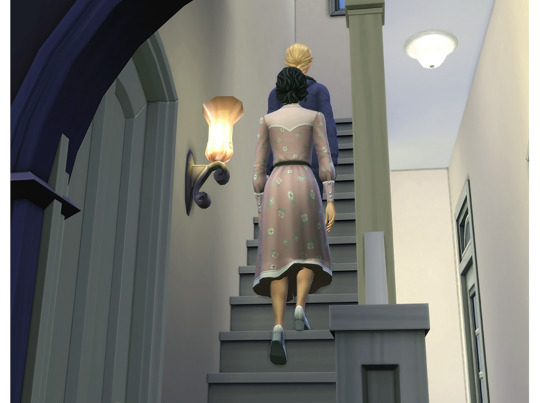

I thought I'd show you the Yellow Room which is the door just to your left. The shared bathroom is at the end of the hall, but if you decide to rent, you'll be the only one using it so far. The ladder goes up to the attic, but I ask that you stay out. The kitchen and my bathroom downstairs are also my private spaces.
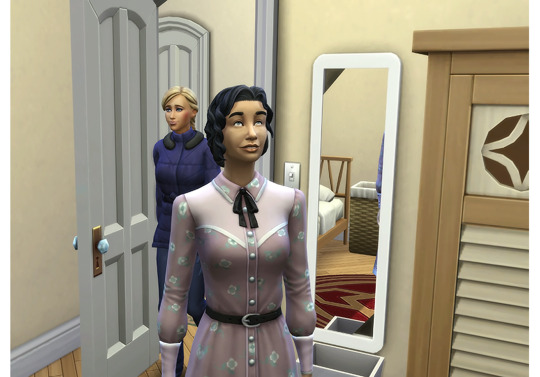
So this is the Yellow Room …
I'm okay with yellow.

I know it's not very big, but…
Oh! I'm okay with it not being very big. I really don't want a lot to take care of, and this bed seems very comfortable
I upgraded it for Mattress Firmness.
Nice!

And here's the mini fridge. You can eat in your room if you want, but please, no cooking. I will provide breakfast every day from 7 to 8 in the morning in the dining room, and dinner at 6 in the evening. There is also a charming café on the other side of the square, if you prefer to have a meal there.
This seems perfect! Is that your cross-stitch on the wall? It's so cute!
Thank you! Now let me show you the basement.
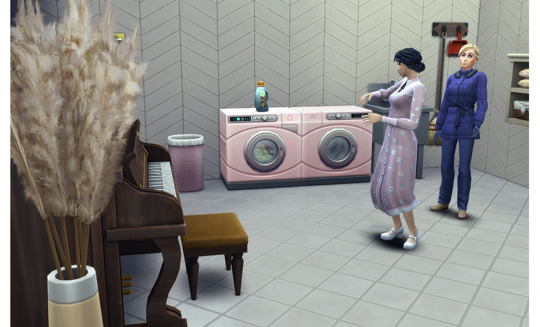
You can see the washer and dryer.
And an old upright piano!
Do you play?
A little. It would be fun to practice!

And I just installed some gym equipment.
Perfect!
There's a bathroom with two shower stalls just beyond the water heater over there.

I can't wait to move in!
I can't wait to have you! Your lease runs from Saturday to Saturday so you can move in tomorrow if you like.
See you tomorrow then!

And this must be Copper! What a handsome fellow!
_________________________________________________

4 notes
·
View notes